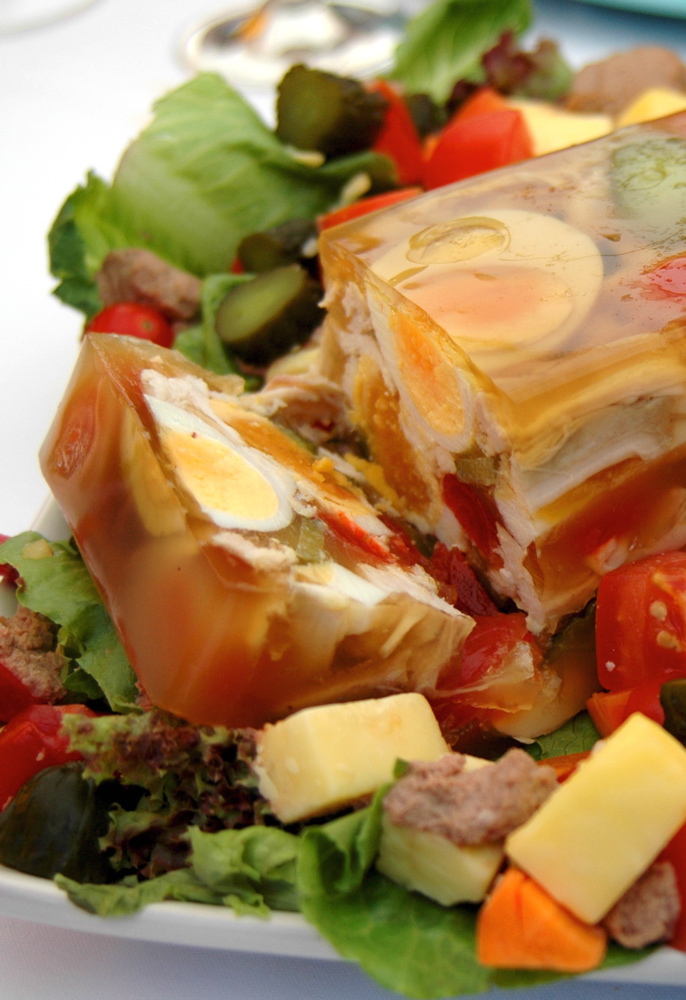- Home
- organic beef gelatin
Blog Categories
Recent Posts
Gelatin: More than just a jiggly dessert
Posted by on
It jiggles and wiggles, and it takes a little extra off your waistline while helping your body work better, be healthier, and function more smoothly. From bone broth to bubbly jello, there are hundreds of recipes for this healthful treat. Our grandmothers and great grandmothers cooked more gelatin-based dishes than we’ve ever dreamed of, and a quick glance through a cookbook from the 1950s shows a list of recipes that include this thickener, from pates to posh cakes and stomach remedies. But somewhere along the way, beef gelatin disappeared off the dining room table at dinner and into the dessert section as an infrequent treat.
What happened to gelatin, and why don’t we use it as widely today? In part, texture. Many of us can’t stomach the idea of slimy meat, so dishes like aspic went out the window. Another reason we’ve left gelatin off the dinner menu? The flavor. Companies added fruit flavors to gelatin powder, creating what is arguably one of the most popular desserts at the expense of health. Natural food fans turn away from the fake sweeteners, artificial colors and flavors, and the overall unnatural appearance of many flavored gelatins. Yet, under the culinary radar, many home cooks have preserved a love of gelatin that is both inspiring and nutritious. Beef gelatin uses span everything from cosmetics to cooking. You'll be surprised by what you learn...
Beef Gelatin and Your Health
More than just a jiggly dessert, beef gelatin can be a true health treat. Beef gelatin uses vary widely, and while it is commonly used for its mild (almost nonexistent) flavor, it’s an excellent addition to any healthy diet for its health properties, as well.
According to WebMD, “Gelatin is used for weight loss and for treating osteoarthritis, rheumatoid arthritis, and brittle bones (osteoporosis). Some people also use it for strengthening bones, joints, and fingernails. Gelatin is also used for improving hair quality and to shorten recovery after exercise and sports-related injury. In manufacturing, gelatin is used for preparation of foods, cosmetics, and medicines.” Although laboratory evidence on gelatin’s uses is skinny (all puns intended) at best right now, there’s reason to believe that it may be effective in easing the pain and improving joint function for osteoarthritis sufferers.
You’ll find this useful protein in many unexpected places, and chances are that you already eat small quantities of it every day, even without trying.
A Protein By Any Other Name…
Gelatin has quite a few names. If you suspect you might already have a little in your diet, take a look at the following list to be sure:
- Collagen Hydrolysate
- Collagen peptide
- Gelatine hydrolysate
- Hydrolyzed gelatine
- Gelatina
- Gelatine
- Hydrolised Collagen
- Hydrolyzed Collagen
- Hydrolyzed Collagen Protein
- Hydrolyzed Gelatin
- Marine Collagen Hydrolysate
Did you notice something about that list? Like the prevalence of the word collagen? I’m sure you’ve heard that term before. Collagen is a key protein in the body. It serves important functions, but they can all be summed up rather quickly. Collagen is a connector. It is the most prevalent protein in animals, and makes up 25-35% of the total protein content of animal organisms. Your eyes, tendons, teeth, ligaments, blood vessels, gut, and even the discs between your vertebrae wouldn’t exist or do their job well without collagen.
Gelatin is simply collagen that has undergone hydrolysis. The bonds between individual collagen fibers are broken down. The result is an amino acid-rich product with a high content of glycine, proline, and glutamic acid, as well as 17 other amino acids. Although the same amino acid blend is found in collagen, it appears to be more bioavailable in gelatin form, and is absorbed as small peptides in the blood.
A Healthier Brain?
In addition to the bone health benefits you’ve probably heard more times than you can count, gelatin might actually help your brain perform its best. Glycine, one of the most prevalent amino acids in gelatin, is used for a wide variety of conditions, including as a treatment for schizophrenia and ischemic stroke. It appears to improve blood flow to the brain when administered within 6 hours of a stroke, and can reduce the brain damage caused by ischemic strokes as a result. How’s that for a helpful dessert?
Some fans of the glycine in gelatin use it to improve memory. Most likely, improved blood flow to the brain could be responsible for any improvement in memory, as well.
Heart Health
L-Proline, or proline, is an amino acid component of gelatin. This powerful little molecule helps to repair muscle after strenuous activity and plays a key role in heart health, too. Some laboratory evidence shows that it may be able to remove atherosclerotic deposits. If you want the max heart health benefit, though, eat your gelatin with vitamin C. According to Tyson Nutraceuticals, without vitamin C, proline simply breaks down and is excreted in urine.
Leaky Gut, be Gone!
If you’re dealing with leaky gut issues, gelatin might just be your best friend. This food is often touted as an anti-inflammatory with the ability to help repair the gut and ease digestion while absorbing excess water. A great pick for leaky gut sufferers, and a tasty one at that.
Lisa over on Feathers in the Woods tried a 3 month gelatin challenge that stretched into 5 months, in part to banish leaky gut. Last I heard, she was loving the results.
You Know Beef Gelatin Uses, But WHAT Do You Choose?
Ok, let me be honest here. I’m biased. I don’t eat pork, and if it accidentally slips into my diet I get very, very sick. As a result, I favor beef gelatin. Fish gelatin exists, but the flavor and results aren’t that great from what I’ve seen. If you’ve ever tried marshmallows made with fish gelatin, you’ll know what I mean (yech!). Horse gelatin is rare, and I grew up in horse country. I can’t do it. Call me a softie, but horses are half-human to me.
That leaves beef. And from the beef gelatin options that exist, very few brands meet my standards. If you’re reading this blog, chances are that you know the benefits of grass-fed beef, so I won’t preach to the choir. I will, however, recommend strongly that you don’t settle for anything less than a grass-fed beef gelatin from a producer you can trust. The nutritional content, life of the cow before slaughter, and quality of the end product are miles better than what you can expect from factor-farmed and corn-fed cattle. And no, grass-finished is not the same as grass-fed. More on that pet peeve another day…
Wondering what brands I like? Personally, I think Great Lakes Gelatin is great (and yes, Wise Choice Market carries their gelatin). There are a few newcomers on the scene that attempt to match their standards, but I’m a skeptic. Until I’ve seen them hold their ethical ground for a year or so, I’m not taking any chances.
The Great Lakes Gelatin line can be a bit confusing with their labeling. They offer both beef gelatin and collagen hydrolysate. Although I’ve told you they are basically the same thing, the company distinguishes between the two by one simple trick: collagen hydrolysate won’t solidify. It’s water soluble. Their gelatin, on the other hand, is great for making all of those goodies like homemade gummy bears and desserts that you think of when someone says gelatin. It won’t hurt you to use both. Collagen hydrolysate can be used to thicken soups and sauces and makes a great supplement.
The Coconut Mama talks about the book The Gelatin Secret. You might want to look into it if you’re serious about adding gelatin to your health routine, and curious how it can help you. In the meantime, check out the recipe below for my favorite gelatin treat.

Gelatin Ambrosia
Ambrosia is a southern dessert. Growing up, I thought ambrosia meant summer, and when I discovered it actually meant food of the gods, I couldn’t have agreed more. It’s good stuff. And it starts with fruit. Adding a little gelatin to the mix just makes it that much better.
Ingredients:
- 1 diced pear
- 1 diced peach
- 1/4 cup mandarin orange slices
- 2 diced pineapple rings
- 24 cherries, pitted and diced
- 4 tbsp. coconut flakes
- 1 cups of organic or freshly juiced fruit juice of choice
- ½ cup cool water
- ½ cup hot water (not boiling, but close)
- 1 tbsp. gelatin powder
- ½ cup homemade mini marshmallows
Directions:
- Pour gelatin powder into a large mixing bowl and add the cool water.
- Stir the mixture. The mixture will begin to thicken.
- Add the hot water.
- Add the juice and mix until the gelatin is completely dissolved.
- Add the fruit, marshmallows, and coconut flakes to the mixture.
- Stir until the fruit is covered completely.
- Cover and refrigerate for 2-3 hours before serving.
That’s all there is to it. One of my favorite desserts in 8 simple steps. If you try it, let me know what you think, and remember that – as delicious as it is – it’s healthy, too. Isn’t it nice to serve your family a dessert you can feel good about eating?
Information provided in this communication is not designed to and does not provide medical advice, professional diagnosis, opinion, treatment or services to you or to any other individual. This is general information for educational purposes only. The information provided is not a substitute for medical or professional care, and you should not use the information in place of a visit, call consultation or the advice of your physician or other healthcare provider. Wise Choice Marketing Inc is not liable or responsible for any advice, course of treatment, diagnosis or any other information, services or product you obtain through Wise Choice Marketing Inc.


 Loading... Please wait...
Loading... Please wait...















